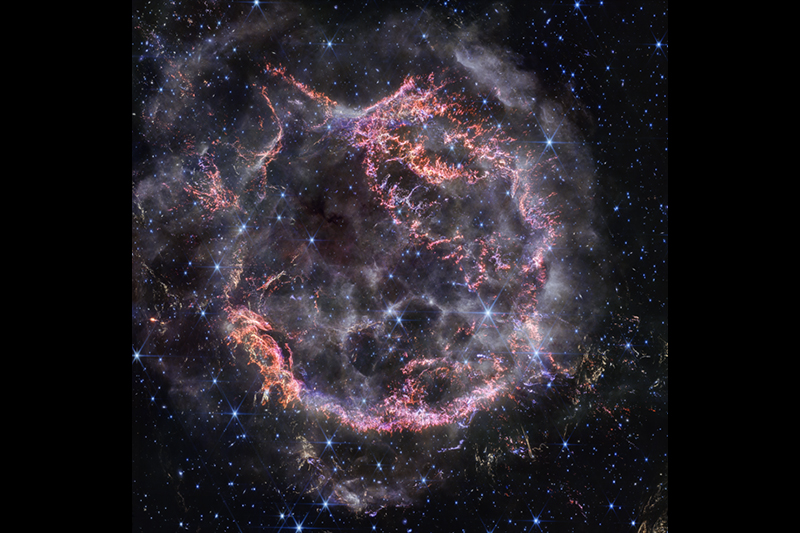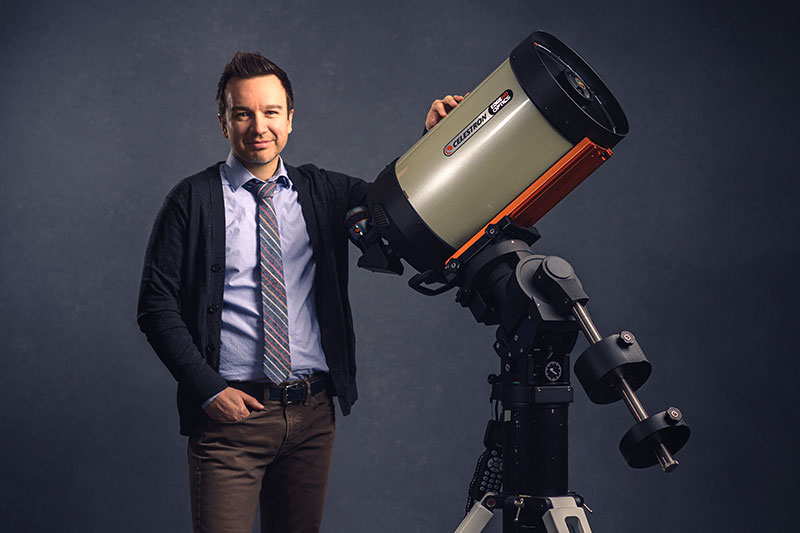December 11, 2023
Star of wonder: Dazzling new image of supernova Cassiopeia A released by First Lady Jill Biden and Purdue astronomer

The stunning image gives humanity the closest and most detailed look ever at the structure of a supernova
WEST LAFAYETTE, Ind. — Ten thousand years ago, a star exploded. Now scientists are getting their best look ever at the details of that explosion, Cassiopeia A. Space-age tools and methods are allowing them to glimpse never-seen-before details that may change forever the way scientists think about star death, star formation and the distribution of matter in the galaxy. And now, a new image of that dead star has a starring role in First Lady Jill Biden’s digital Advent calendar this year.
The James Webb Space Telescope hosts an array of tools that includes the NIRCam, a telescope that looks at light in the near-infrared wavelengths. Astronomers use NIRCam observations to map out matter in those wavelengths and assign colors to make previously unseen features visible.
Dan Milisavljevic is an astronomer and an expert on star explosions. An associate professor of physics and astronomy in Purdue University’s College of Science, Milisavljevic (pronounced mili-sahv-la-vich) leads the project team whose data contributed to the staggeringly detailed new image.
“We’ve never had this kind of look at an exploded star before,” Milisavljevic said. “Supernovae are primary drivers of cosmological evolution. The energies, their chemical abundances — there is so much that depends on our understanding of supernovae. This is the closest look we’ve had at a supernova in our galaxy.”
Additional Information
- New Webb telescope image reveals wonders, beauty, secrets of star structure and building blocks of life
- Purdue astronomer speechless in the face of new images from space telescope
- Uncovering a star’s demise: Supermassive black hole tears apart a giant star in a display brighter, more energetic and longer-lasting than any observed before
 Danny Milisavljevic’s research on the James Webb Space Telescope led to his new detailed image of stellar remnant Cassiopeia A in which infrared light is translated into visible-light wavelengths. (Purdue University photo)
Download image
Danny Milisavljevic’s research on the James Webb Space Telescope led to his new detailed image of stellar remnant Cassiopeia A in which infrared light is translated into visible-light wavelengths. (Purdue University photo)
Download image
Milisavljevic leads a team of nearly 40 scientists and researchers from more than 30 institutions — including Harvard, Princeton and Johns Hopkins universities, as well as Los Alamos National Laboratory and the SETI Institute — in studying Cassiopeia A, one of the more puzzling objects in the galaxy. Cassiopeia A comprises the remnants of a supernova explosion and has at its heart a neutron star that doesn’t behave the way scientists think neutron stars ought to behave.
“It’s staggering,” Milisavljevic said. “Some features have popped up that are completely new — that will change the way we think about stellar life cycles. And other features that have been studied disappear in the new NIRcam image. Why? And what does that mean for our understanding of how stars form and die?”
Before the James Webb Space Telescope started studying the heavens in 2022, the Hubble Space Telescope allowed humans to see farther into space and deeper into time. The James Webb Space Telescope is bigger, more complex and orbits farther from the Earth than Hubble, allowing it unprecedented opportunities for interstellar sleuthing. The James Webb Space Telescope looks even farther into space and time and with an unprecedented range of wavelengths and strength of definition. The knowledge it uncovers may help scientists take the next small steps out into the universe — and discern where humans want to go next and why.
“The images don’t just look better — they’re different,” Milisavljevic said. “It’s not just higher resolution, but the James Webb Space Telescope is looking at infrared emissions sensitive to a variety of different elements and molecules that Hubble cannot access. It’s exciting to look at the promise of the James Webb Space Telescope coming true.”
About Purdue University
Purdue University is a public research institution with excellence at scale. Ranked among top 10 public universities and with two colleges in the top 4 in the United States, Purdue discovers and disseminates knowledge with a quality and at a scale second to none. More than 105,000 students study at Purdue across modalities and locations, with 50,000 in person on the West Lafayette campus. Committed to affordability and accessibility, Purdue’s main campus has frozen tuition 12 years in a row. See how Purdue never stops in the persistent pursuit of the next giant leap, including its first comprehensive urban campus in Indianapolis, the new Mitchell E. Daniels, Jr. School of Business, and Purdue Computes, at https://www.purdue.edu/president/strategic-initiatives.
Writer/Media contact: Brittany Steff, bsteff@purdue.edu
Source: Dan Milisavljevic, dmilisav@purdue.edu

